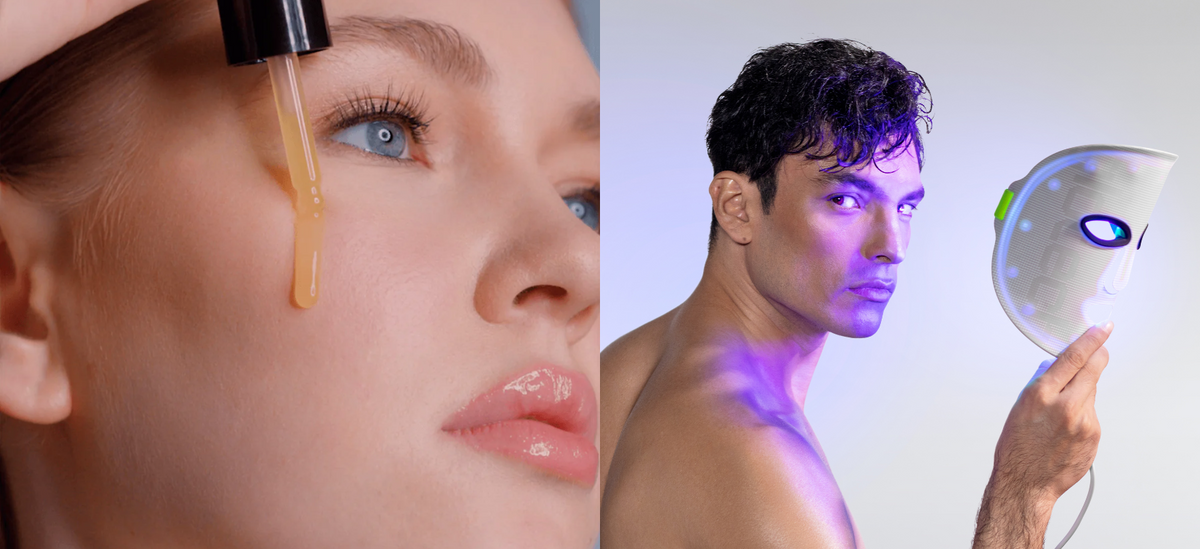
Acne Serum vs. Blue Light Therapy: Which is Better?
|
|
Time to read 3 min


Written by:
|
|
Time to read 3 min
LED-SCIENCE
[07-18-2025]
by Madison Carter
If your skincare routine feels like a guessing game, you’re not alone. From serums to tech devices, there’s no shortage of acne solutions.
We’ll help you understand whether LED light therapy for acne or a classic acne serum is the better choice for your skin.
Table of contents
Acne forms when pores become clogged with oil, dead skin cells, and bacteria. This creates inflammation, leading to whiteheads, blackheads, and cysts.
Hormonal changes, environmental stress, poor diet, and skin sensitivity all play roles in how breakouts form and worsen.
Identifying what’s driving your acne is key to choosing the right treatment—especially when comparing topical serums with light-based therapies.
Acne serums are lightweight, fast-absorbing formulas that deliver concentrated active ingredients to the skin.
They’re usually designed to unclog pores, reduce oil production, and prevent new breakouts.
Popular acne-fighting ingredients include salicylic acid, benzoyl peroxide, niacinamide, and retinol.
Easy to layer in your routine
Effective for mild to moderate breakouts
Results vary depending on skin type and consistency
Less effective on deep or cystic acne
When serums aren't cutting it, LED devices like Glotech Pro and Glotech Lite offer a non-invasive solution supported by clinical science.
Blue light therapy for acne uses a specific wavelength (typically around 415nm) to target Cutibacterium acnes (formerly P. acnes) bacteria.
This treatment reduces inflammation and helps prevent future breakouts by regulating sebum production.
It’s safe for all skin types and doesn’t require downtime, making it ideal for consistent at-home use.
Reduces inflammation without irritating the skin barrier
Prevents future breakouts by balancing oil production.
Glotech Pro is a lightweight, medical-grade silicone LED mask offering both blue and red light wavelengths.
Blue light fights active acne while red light stimulates collagen production , aiding in skin recovery and minimizing post-acne marks.
It’s ideal for users seeking an advanced, dermatologist-level treatment from home.
Glotech Lite features the same high-intensity blue light therapy in a streamlined, durable plastic design.
It’s a cost-effective and beginner-friendly option for anyone exploring light-based acne solutions without compromising on power.
| Criteria | Acne Serums | Blue Light Therapy for Acne |
|---|---|---|
| Mechanism | Targets skin surface with actives | Penetrates to kill acne-causing bacteria |
| Onset of Results | 2–6 weeks | 1–2 weeks with regular use |
| Potential Irritation | High with strong actives | Low; safe for sensitive skin |
| Convenience | Easy to apply, may require layering | Hands-free, 10–20 min sessions |
| Long-Term Effect | Needs consistent reapplication | Helps maintain clearer skin over time |
Verdict: Blue light therapy is less irritating , more targeted , and a better long-term option for stubborn breakouts.
You don’t have to choose. Many dermatologists recommend combining LED light therapy with targeted serums for faster and more visible improvement.
Using LED therapy helps calm inflammation and prep the skin , allowing serums to absorb better and work more efficiently.
Best LED + serum combination: Vitamin C Ageless Complex (post-LED) = brightens, strengthens skin barrier, and helps fade post-acne marks
Serums offer convenience and spot-targeting, but they’re not a one-size-fits-all solution.
For deeper, faster, and longer-lasting results, blue light therapy for acne is a more advanced and proven option.
We use cookies to make things better
